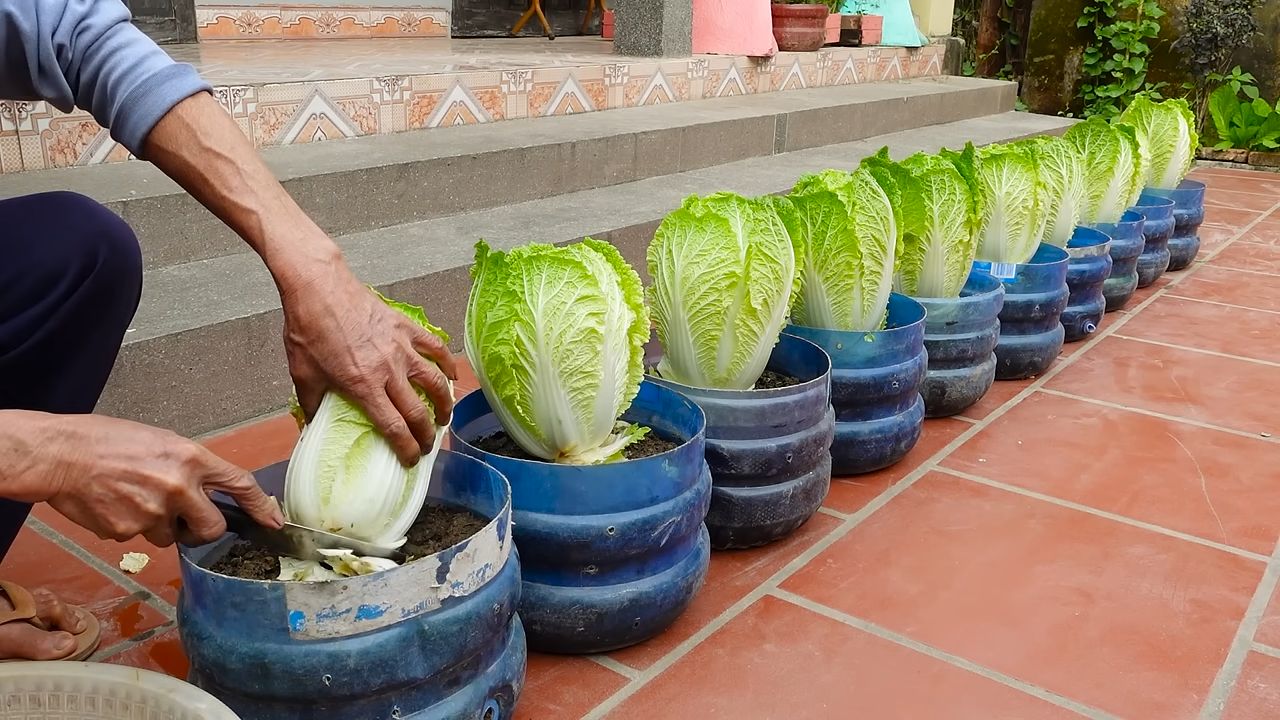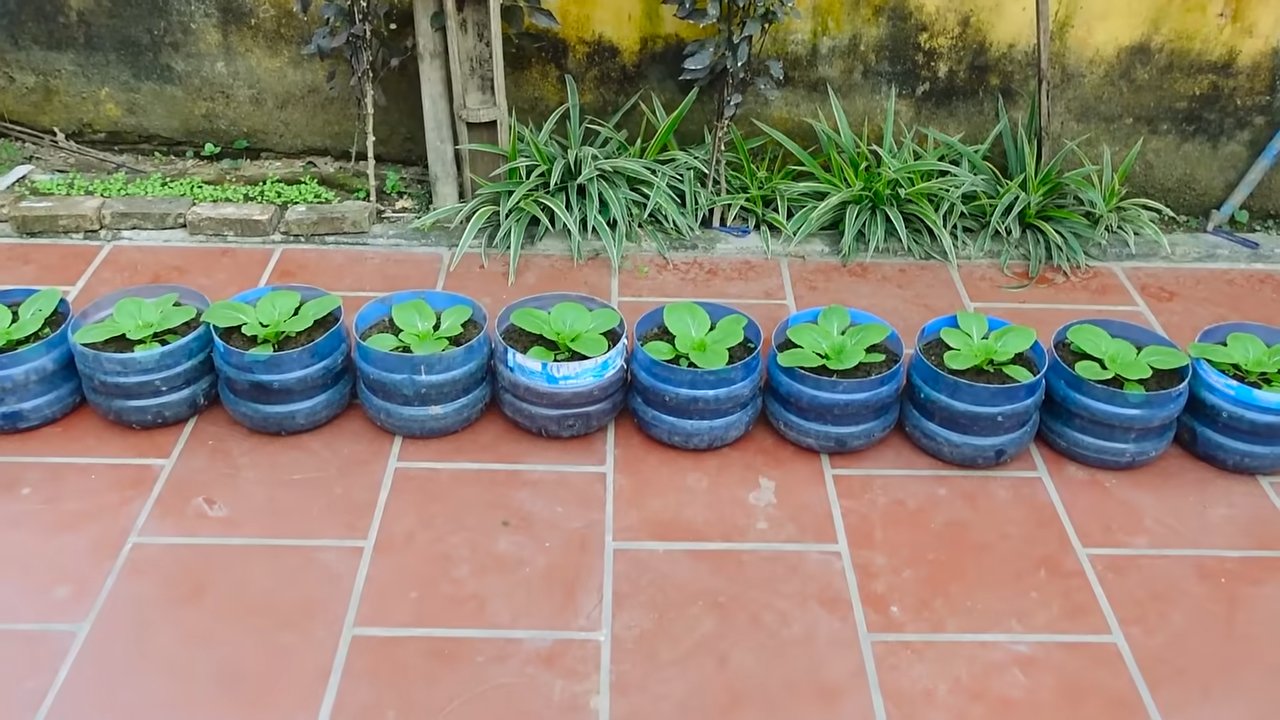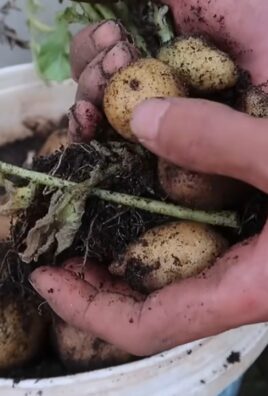Growing Chinese Cabbage at Home can seem daunting, especially if you’re new to gardening. But trust me, with a few simple tricks and a little know-how, you can enjoy fresh, crisp Chinese cabbage straight from your backyard! Forget those wilted, overpriced heads at the grocery store – imagine the satisfaction of harvesting your own delicious, healthy greens.
For centuries, Chinese cabbage has been a staple in Asian cuisine, prized for its versatility and nutritional benefits. From stir-fries to kimchi, this leafy vegetable adds a delightful crunch and subtle sweetness to countless dishes. Its cultivation dates back to the 15th century in the Yangtze River Delta region of China, and it has since spread across the globe, becoming a beloved ingredient in diverse culinary traditions.
Why should you try growing Chinese cabbage at home? Well, besides the obvious benefit of having fresh, organic produce readily available, it’s also a surprisingly rewarding experience. Many people struggle with store-bought vegetables lacking flavor or freshness. Growing Chinese Cabbage at Home allows you to control the entire process, from seed to table, ensuring the highest quality and taste. Plus, it’s a fantastic way to connect with nature, de-stress, and learn new skills. In this article, I’ll share some easy-to-follow DIY tricks and hacks that will help you cultivate a thriving Chinese cabbage patch, even if you have limited space or gardening experience. Let’s get started!

Chinese Cabbage Self-Cultivation: A Comprehensive DIY Guide
Hello garden friends! Chinese cabbage is an incredibly versatile and healthy vegetable that can be wonderfully grown in your own garden. I’ll show you how to do it yourself. Don’t worry, it’s easier than you think!
What you need for growing Chinese cabbage:
- Seeds: Choose a variety suitable for your region. There are early and late varieties.
- Seed starting mix: For pre-growing indoors or in a greenhouse.
- Garden soil: Well-prepared soil in the garden bed.
- Compost or organic fertilizer: To enrich the soil.
- Seed starting pots or trays: For pre-growing.
- Watering can or garden hose: For watering.
- Slug pellets (optional): For protection against slugs.
- Fleece (optional): For protection against pests and frost.
- Spade or garden claw: For digging and loosening the soil.
- Pruning shears or knife: For harvesting.
The best time for sowing:
- Spring sowing (for summer harvest): March to April (pre-growing indoors) or April to May (direct sowing outdoors).
- Summer sowing (for autumn harvest): July to August (direct sowing outdoors). Summer sowing is often the better choice, as the plants are then less susceptible to pests.
Preparation is everything: The right location and soil
Chinese cabbage loves the sun! So choose a sunny spot in the garden. The soil should be loose, humus-rich, and well-drained. Chinese cabbage does not like waterlogging.
- Prepare the soil: Dig the soil thoroughly and remove stones and weeds. Mix in compost or organic fertilizer to enrich the soil. I always use a good amount of compost, my plants love it!
- pH value: The ideal pH value is between 6.0 and 7.0. You can check the pH value with a soil test and adjust it if necessary with lime or sulfur.
Sowing: How to do it right
There are two options: pre-growing indoors or direct sowing outdoors. I often prefer pre-growing because it gives me a small head start.
Pre-growing indoors (or greenhouse):
- Prepare seed starting pots: Fill the seed starting pots with seed starting mix.
- Sow seeds: Place 2-3 seeds per pot about 1 cm deep into the soil.
- Water: Water the soil carefully.
- Place in a warm spot: Place the pots in a warm and bright location (approx. 18-20°C).
- Keep moist: Keep the soil moist, but not wet.
- Prick out: As soon as the seedlings have 2-3 true leaves, you can prick them out. This means transplanting the strongest plants into larger pots.
Direct sowing outdoors:
- Prepare seedbed: Loosen the soil and remove weeds.
- Make furrows: Draw furrows about 40 cm apart.
- Sow seeds: Place the seeds in the furrows and cover them with soil.
- Water: Water the soil carefully.
- Thin out: As soon as the seedlings have emerged, thin them out to a distance of approx. 30-40 cm. This means removing the weaker plants so that the stronger ones have enough space to grow.
Planting: Into the bed!
As soon as the young plants are strong enough (approx. 4-6 weeks after sowing), they can be planted into the bed.
- Prepare the bed: Loosen the soil and remove weeds.
- Dig planting holes: Dig planting holes about 30-40 cm apart.
- Plant seedlings: Place the young plants in the planting holes and fill with soil.
- Water: Water the plants thoroughly.
Care: How to keep your Chinese cabbage healthy and strong
- Watering: Chinese cabbage needs regular water, especially during dry periods. Make sure the soil is always slightly moist.
- Fertilizing: Fertilize the plants regularly with organic fertilizer or compost. I fertilize my plants every 2-3 weeks.
- Weeding: Keep the bed weed-free so that the Chinese cabbage gets enough nutrients and light.
- Pest control: Unfortunately, Chinese cabbage is susceptible to pests such as slugs, cabbage white butterflies, and flea beetles.
- Slugs: Slug pellets or slug fences can help. I also like to pick up slugs in the evening.
- Cabbage white butterflies: A fleece net protects the plants from cabbage white caterpillars.
- Flea beetles: Regular watering and hoeing the soil can help.
Harvest: Finally harvest!
Depending on the variety and sowing time, you can harvest Chinese cabbage after approx. 8-12 weeks.
- Recognize ripeness: The head should be firm and closed.
- Harvest: Cut off the head with a sharp knife or pruning shears.
Additional tips and tricks:
- Crop rotation: Do not grow Chinese cabbage in the same spot every year to prevent diseases and pests.
- Companion planting: Good neighbors for Chinese cabbage include lettuce, spinach, radishes, and dill.
- Winter protection: In cold regions, you can protect Chinese cabbage from frost with fleece or straw.
- Variety selection: There are many different Chinese cabbage varieties. Find out which variety is best suited for your region and your needs. Some popular varieties are ‘Kasumi’, ‘Optiko’, and ‘Blues’.
- Aphids: A strong stream of water or a treatment with soapy water often helps with aphid infestation.
- Clubroot: Watch out for signs of clubroot (swollen roots). Infested plants should be removed and the soil treated with lime.
Chinese cabbage in the kitchen: Versatile and delicious
Chinese cabbage is incredibly versatile in the kitchen. You can eat it raw in salads, steam it, fry it, boil it, or ferment it. It is rich in vitamins and minerals and simply delicious!
- Salad: Chinese cabbage is a great base for salads. Combine it with carrots, bell peppers, cucumbers, and a delicious dressing.
- Stir-fry: Chinese cabbage goes perfectly in stir-fries. Fry it with other vegetables and soy sauce.
- Soup: Chinese cabbage can also be used in soups. It gives the soup a slight sweetness and a pleasant texture.
- Kimchi: Chinese cabbage is the main ingredient for kimchi, a Korean national dish.
- Stuffed Chinese cabbage: The leaves can also be stuffed and baked in the oven.
I hope this guide helps you successfully grow your own Chinese cabbage. Happy gardening and bon appétit!

Conclusion
So, there you have it! Growing Chinese cabbage at home isn’t just a gardening project; it’s a gateway to fresher, healthier meals and a deeper connection with the food you eat. We’ve walked you through the process, from selecting the right seeds to harvesting your bountiful crop. But why should you take the plunge and dedicate a little space in your garden to this leafy green?
Firstly, the taste difference is undeniable. Store-bought Chinese cabbage simply can’t compare to the crisp, subtly sweet flavor of freshly harvested, homegrown leaves. You control the growing conditions, ensuring optimal taste and texture. Plus, you know exactly what’s gone into your cabbage – no pesticides, no hidden chemicals, just pure, natural goodness.
Secondly, growing your own Chinese cabbage is incredibly rewarding. There’s a unique satisfaction in nurturing a plant from seed to harvest, watching it thrive under your care. It’s a tangible connection to the natural world, a reminder of the simple pleasures of life.
Thirdly, it’s a cost-effective way to enjoy this versatile vegetable. Packaged Chinese cabbage can be surprisingly expensive, especially if you’re buying organic. By growing your own, you can significantly reduce your grocery bill and have a steady supply of fresh greens at your fingertips.
But the benefits don’t stop there. Growing Chinese cabbage at home also allows for experimentation and customization. Want to try a different variety? Go for it! There are numerous cultivars to choose from, each with its own unique characteristics. Consider trying ‘Michihili’ for its tall, cylindrical heads, or ‘Wombok’ for its rounder, more compact shape.
Feeling adventurous? Try companion planting! Marigolds can help deter pests, while dill can attract beneficial insects. Experiment with different combinations to see what works best in your garden. You can also adjust your planting schedule to extend your harvest season. Succession planting, where you sow seeds every few weeks, will ensure a continuous supply of fresh Chinese cabbage throughout the growing season.
And don’t forget about the versatility of Chinese cabbage in the kitchen! It’s delicious in stir-fries, soups, salads, and even kimchi. Its mild flavor makes it a perfect complement to a wide range of dishes. Use it as a wrap for your favorite fillings, add it to your morning smoothie for a boost of nutrients, or simply sauté it with garlic and ginger for a quick and easy side dish.
We encourage you to give growing Chinese cabbage at home a try. It’s a relatively easy and incredibly rewarding experience. Don’t be afraid to experiment, learn from your mistakes, and most importantly, have fun!
Once you’ve harvested your first crop, we’d love to hear about your experience. Share your tips, tricks, and favorite recipes in the comments below. Let’s build a community of home gardeners who are passionate about growing their own food. Together, we can cultivate a healthier, more sustainable future, one head of Chinese cabbage at a time. So, grab your seeds, get your hands dirty, and start growing! You won’t regret it.
Frequently Asked Questions (FAQ)
What is the best time of year to plant Chinese cabbage?
The best time to plant Chinese cabbage depends on your climate. Generally, it’s a cool-season crop, so you’ll want to avoid planting during the hottest months of summer. For a fall harvest, sow seeds in late summer or early fall, about 6-8 weeks before the first expected frost. For a spring harvest, start seeds indoors 4-6 weeks before the last expected frost and transplant them outdoors once the weather warms up. In warmer climates, you may be able to grow Chinese cabbage throughout the winter.
How much sunlight does Chinese cabbage need?
Chinese cabbage needs at least 6 hours of sunlight per day to thrive. Choose a location in your garden that receives full sun for optimal growth. If you live in a particularly hot climate, some afternoon shade can be beneficial to prevent the leaves from scorching.
What kind of soil is best for growing Chinese cabbage?
Chinese cabbage prefers well-drained, fertile soil that is rich in organic matter. Amend your soil with compost or well-rotted manure before planting to improve its drainage and fertility. A soil pH of 6.0 to 7.5 is ideal. You can test your soil pH with a simple soil testing kit available at most garden centers.
How often should I water Chinese cabbage?
Chinese cabbage needs consistent moisture to grow properly. Water deeply and regularly, especially during dry periods. Aim to keep the soil consistently moist but not waterlogged. Mulching around the plants can help retain moisture and suppress weeds.
What are some common pests and diseases that affect Chinese cabbage?
Common pests that can affect Chinese cabbage include aphids, cabbage worms, flea beetles, and slugs. Diseases include clubroot, downy mildew, and black rot. Regularly inspect your plants for signs of pests or diseases and take appropriate action. Organic pest control methods, such as introducing beneficial insects or using insecticidal soap, can be effective. Crop rotation and good sanitation practices can help prevent diseases.
How do I harvest Chinese cabbage?
You can harvest Chinese cabbage when the heads are firm and tightly packed. Use a sharp knife to cut the head at the base of the plant. The outer leaves can be harvested individually as needed.
Can I grow Chinese cabbage in containers?
Yes, you can grow Chinese cabbage in containers, but you’ll need to choose a large container that is at least 12 inches in diameter and 12 inches deep. Use a well-draining potting mix and water regularly. Container-grown Chinese cabbage may need more frequent fertilization than plants grown in the ground.
How do I store Chinese cabbage after harvesting?
Store unwashed Chinese cabbage in a plastic bag in the refrigerator. It should last for up to two weeks. You can also blanch and freeze Chinese cabbage for longer storage.
What are some good companion plants for Chinese cabbage?
Good companion plants for Chinese cabbage include marigolds, dill, chamomile, and nasturtiums. These plants can help deter pests and attract beneficial insects. Avoid planting Chinese cabbage near other members of the brassica family, such as broccoli, cauliflower, and kale, as they can attract the same pests and diseases.
Can I save seeds from my Chinese cabbage plants?
Yes, you can save seeds from your Chinese cabbage plants, but it’s important to note that Chinese cabbage is an open-pollinated plant, so the seeds may not come true to type. To save seeds, allow a few plants to bolt (flower) and produce seed pods. Once the seed pods are dry and brown, harvest them and extract the seeds. Store the seeds in a cool, dry place.
Is growing Chinese cabbage at home difficult?
No, growing Chinese cabbage at home is not difficult, especially if you follow the tips and guidelines outlined in this article. With a little bit of planning and effort, you can enjoy a bountiful harvest of fresh, delicious Chinese cabbage from your own garden. The key is to provide the right growing conditions, including adequate sunlight, well-drained soil, and consistent moisture. Don’t be afraid to experiment and learn from your mistakes. Gardening is a journey, and every season brings new opportunities to learn and grow.





Leave a Comment